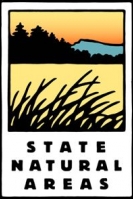About the State Natural Areas Program
Before intensive European settlement in the 1830s, Wisconsin's landscape was a mosaic of more than 75 unique types of natural communities, ranging from prairies and oak savannas in the south to pine forests and boggy wetlands in the north. Together, these ecosystems harbored the full complement of our state's rich plant and animal species diversity. Over the decades, the quality and extent of those natural communities were significantly reduced by land use changes, agricultural and logging practices, and the ecological impact of altered natural disturbance regimes (such as fire and flooding), white-tailed deer herbivory, the spread of non-native invasive plant species and climate change. Today, the last remaining vestiges of Wisconsin's native landscape that have escaped extensive alteration or substantially recovered from disturbance over time are called "natural areas."
We owe much to Wisconsin's early 1930s, 40s, and 50s conservationists, including Aldo Leopold, botanists Norman Fassett and Albert Fuller and plant ecologist John Curtis, who recognized the importance of natural areas and the consequences of their loss. Through their advocacy, the legislature created the State Board for the Preservation of Scientific Areas in 1951 as the nation's first state-sponsored natural area protection program. That first board evolved into today's State Natural Areas (SNA) Program.
SNA selection
The process of establishing a State Natural Area begins with the evaluation of a site identified through field inventories conducted by DNR ecologists. Assessments consider a site's overall ecological quality and diversity, the extent of past disturbance, long-term viability, the context within the more extraordinary landscape, and the rarity of features on local and global scales. Sites are considered for potential SNA designation in one or more of the following categories:
- outstanding natural community,
- critical habitat for rare species of plants or animals,
- ecological benchmark reference area,
- significant geological or archaeological feature; and
- exceptional site for natural area research and education.
Laws establishing the State Natural Areas program are found in Wisconsin Statute Chapter 23 [exit DNR].
Establishment and protection
A State Natural Area may be established and afforded protection in three ways. The first is through direct acquisition of land or easement by the DNR's SNA Program. The department acquires property only from willing sellers and pays fair market value based on certified appraisals. It also accepts donations of eligible lands. The second means is through the DNR's property master planning process. Land that meets SNA standards and is already in DNR ownership, such as a wildlife area, state park, fishery area or state forest, may be classified as an SNA in the property's master plan. The third way to establish a SNA is through a formal written agreement between the DNR and a non-profit organization, educational institution or government entity that owns land of SNA quality. The SNA Program owes much of its success to these agreements with partners such as The Nature Conservancy, USDA Forest Service, National Park Service, other land trusts, conservation organizations and state and local governments. More than one-third of SNAs in the system are partner-owned.
Once secured by purchase or agreement, sites are formally "designated" as SNAs and become part of the SNA system. Designation confers a significant level of land protection through state statutes, administrative rules and guidelines. A higher level of protection is afforded by the legal "dedication" of SNAs through Articles of Dedication, a special kind of perpetual conservation easement.
Management
Principles of ecosystem management guide land stewardship. For some SNAs, the best management prescription is to "let nature take its course" and allow natural processes and their subsequent effects to proceed without constraint. However, some functions, such as the encroachment of woody vegetation and the spread of invasive and exotic plant species, threaten the biological integrity of many SNAs. These sites require direct, hands-on management and, in some cases, the reintroduction of natural functions -- such as wildfire -- that are essentially absent from the landscape.
Visitation and use
Please also see our Visitor Guide

